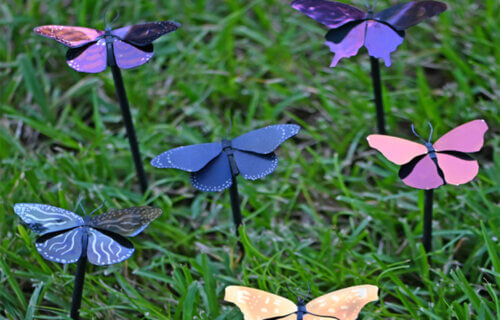ORANGE COUNTY, Fla. — Environment-minded folks (and their homes) could soon be glowing like never before, thanks to the creation of an eco-friendly decor. Instead of pigment-based colored paint, University of Central Florida (UCF) researchers are the first to develop a more light-weight, energy-saving paint inspired by vibrant butterflies.
Right now, pigment-based paints require artificially synthesized molecules, but this natural alternative would prevent the need for that.
“The range of colors and hues in the natural world are astonishing — from colorful flowers, birds and butterflies to underwater creatures like fish and cephalopods,” says Debashis Chanda, a professor in UCF’s NanoScience Technology Center in a statement. “Structural color serves as the primary color-generating mechanism in several extremely vivid species where geometrical arrangement of typically two colorless materials produces all colors. On the other hand, with manmade pigment, new molecules are needed for every color present.”
Inspired by the beauty of the world, Chanda and his research group pioneered a plasmonic paint, which utilizes nanostructure materials like aluminum and aluminum oxide instead of pigments to generate colors. One reason using pigments is more impractical than this method is that these colorants control the absorption of light based on the electrical property of the material, thus requiring a new molecule for every color. This newly-developed way of generating color can control the reflection, scattering, or absorption of light simply geometric arrangement of the nanostructures.
Even better, these nanostructures are better for the environment than pigments used now. The researchers discuss that plasmonic paint is able to absorb much less heat because it can reflect the whole infrared system, allowing the surface beneath it to stay 25-30 degrees cooler than if standard paint were used.

“Over 10% of total electricity in the U.S. goes toward air conditioner usage,” Chanda says. “The temperature difference plasmonic paint promises would lead to significant energy savings. Using less electricity for cooling would also cut down carbon dioxide emissions, lessening global warming.”
This alternative even yields longer-lasting paint!
“Normal color fades because pigment loses its ability to absorb photons,” Chanda says. “Here, we’re not limited by that phenomenon. Once we paint something with structural color, it should stay for centuries.”
Finally, this novel paint is a great alternative because of how lightweight it is. To put it in perspective, Chanda explains how you’d only need about three pounds of it to cover an entire Boeing 747 plane. Over 1,000 pounds of commercial paint would be needed.
Chanda looks ahead to further exploring ways to make this paint a viable option that’s available commercially, specifically it’s energy-saving capacities.
“The conventional pigment paint is made in big facilities where they can make hundreds of gallons of paint,” he says. “At this moment, unless we go through the scale-up process, it is still expensive to produce at an academic lab. We need to bring something different like, non-toxicity, cooling effect, ultralight weight, to the table that other conventional paints can’t.”
The findings are published in the journal Science Advances.

Is there any way to purchase some? I read that it is produced in a lab but am hoping that perhaps they sell some and get research from the purchasers perhaps? I would be interested in doing this and perhaps test on others in my area of the country namely Maine.